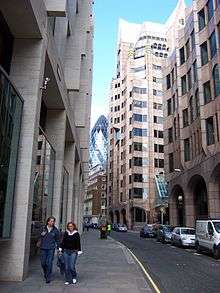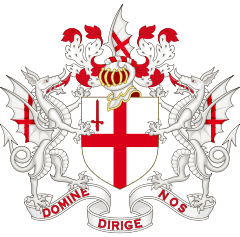Mincing Lane
 Looking north up Mincing Lane, with Minster Court on the right and 30 St Mary Axe in the background | |
| Length | 0.1 mi (0.2 km) |
|---|---|
| Location | London, United Kingdom |
| North end | Fenchurch Street |
| To | Great Tower Street |
Mincing Lane is a short one-way street in the City of London linking Fenchurch Street to Great Tower Street. In the late 19th century it was the world's leading centre for tea and spice trading.
Etymology
Its name is a corruption of Mynchen Lane — so-called from the tenements held there by the Benedictine 'mynchens' or nuns of the nearby St Helen's Bishopsgate church (from Minicen, Anglo-Saxon for a nun; minchery, a nunnery).[1]
A Dictionary of London by Henry A. Harben (1918) describes it as follows:[2]
Mincing Lane
- North out of Great Tower Street to Fenchurch Street at No. 42 (P.O. Directory). In Tower and Langbourn Wards.
- Earliest mention: "Menechinelane," 1273-4 (Ct. H.W. I. 17).
- Other forms of name: "Mengenelane," 1290-1 (ib. 95). "Mangonelane," 1291 (ib. 96). "Monechenelane," 1291 (ib. 101). "Menchenelane," 1294-5 (ib. 119). "Manionelane," 1295 (ib. 121) and 1311 (Cal. L. Bk. D. p. 77). "Menchonelane," 1304 (Ct. H.W. I. 162). "Manchonlane," 1306-7 (ib. 184). "Menionelane," 1312 (ib. 230). "Mangonelane," 1320 (ib. 288). "Mengonelane," 1321 (ib. 292). "Mengeoneslane," 1324 (ib. 309). "Mengeonlane," 1330 (ib. 361). "Myniounlane," 1349 (ib. 577). "Munchenlane," 1348-9 (ib. 528). "Monechunelane," 1349 (ib. 553). "Manchonelane," 36 Ed. III. (Ch. I. p.m. pt. 2, 71). "Minchonlane," 1393 (Ct. H.W. II. 299). "Mynchenlane," 1398-9 (ib. 337). "Mynchyn lane," 28 H. VIII. (Lond. I. p.m. Lond. and Midd. Arch. Soc. VII. (p. 55). "Mynsing Lane," 1601 (H. MSS. Com. Salisbury, XI. 315).
- The A.S. word "mynechenu" = female of "munuc" = monk.
- Halliwell in his Dictionary of Archaic and Provincial Words gives "Minch" = a nun, and it is suggested that this street derives its name through this word from the A.S. "mynechenu," the "mynchens" or nuns of St. Helens who held property there.
- At the north-eastern end of this lane remains of a Roman bath, hypocaust, etc., have been found, and Roman pavements on the western side of the street.
In addition, the entry "Mngenelane" in Harben's Dictionary suggests "Mngenelane = Mengenelane".
History
It was for some years the world's leading centre for tea and spice trading after the British East India Company successfully took over all trading ports from the Dutch East India Company in 1799. It was the centre of the British opium business (comprising 90% of all transactions), as well as other drugs in the 18th century.[3] Businesses in the British slave trade, such as Hibbert, Purrier and Horton (founded 1770), were also based in Mincing Lane.
It is mentioned in chapter 16 of Charles Dickens' Our Mutual Friend, where it is briefly described:
- "[Bella] arrived in the drug-flavoured region of Mincing Lane, with the sensation of having just opened a drawer in a chemist's shop."
In 1834, when the East India Company ceased to be a commercial enterprise, and tea became a 'free trade' commodity, tea auctions were held in the London Commercial Salerooms on Mincing Lane. Tea merchants established offices in and around the street, earning it the nickname 'Street of Tea'.[4]
A notable building is the livery hall of the Worshipful Company of Clothworkers. The current building, opened in 1958, is the sixth to stand on the site; the fourth was burnt down in the Great Fire of London and the fifth was destroyed during the Blitz of World War II.[5]
A modern landmark partly bounded by Mincing Lane is Plantation Place, completed in 2004, and its sister building Plantation Place South.
Minster Court
Minster Court is a complex of three office buildings, completed between 1991 and 1992 and designed by architects GMW Partnership.[6] During the final phase of fitting-out on 7 August 1991, there was a fire in the atrium of No. 3 Minster Court which caused a serious delay in completion. The style has been described as "postmodern-gothic".

In the forecourt, on Mincing Lane, are three bronze horses that are each over 3 metres tall, sculpted by Althea Wynne; they have been nicknamed "Dollar", "Yen" and "Sterling".
It appeared briefly in Disney's 1996 live-action movie 101 Dalmatians as the exterior of Cruella De Vil's haute couture fashion house, "House of DeVil".[7] It also appeared as the location of the architectural practice of Peter Manson (played by Trevor Eve) in the 2010 remake of Bouquet of Barbed Wire.
London Underwriting Centre
Situated in No. 3 Minster Court, the London Underwriting Centre (LUC) is intended to run in parallel with the Underwriting Room at Lloyd's of London, providing a facility for insurance underwriters to meet brokers at a single venue (the Lloyd's building itself being only open to Lloyd's syndicate underwriters). The LUC specialises in international insurance and reinsurance,[8] and can be visited by up to 4,000 brokers each day.[9]
References
- ↑ E. Cobham Brewer 1810–1897. Dictionary of Phrase and Fable. 1898.
- ↑ Mincing Lane,
- ↑ Booth, Martin (1996). Opium: A History. pp. 52–53.
The centre of opium business was around Mincing Lane in London, where 90 per cent of the trade was conducted.
- ↑ Tea Council
- ↑ Old London Maps
- ↑ http://www.e-architect.co.uk/london/minster_court.htm
- ↑ "101 Dalmatians filming locations". Movie-Locations.com. Retrieved 4 October 2014.
- ↑ http://www.bcctc.ca/conn18-4/underwrt.html
- ↑ http://www.skyscrapernews.com/buildings.php?id=139
External links
![]() Media related to Mincing Lane at Wikimedia Commons
Media related to Mincing Lane at Wikimedia Commons
Coordinates: 51°30′39″N 0°04′54″W / 51.51083°N 0.08167°W
